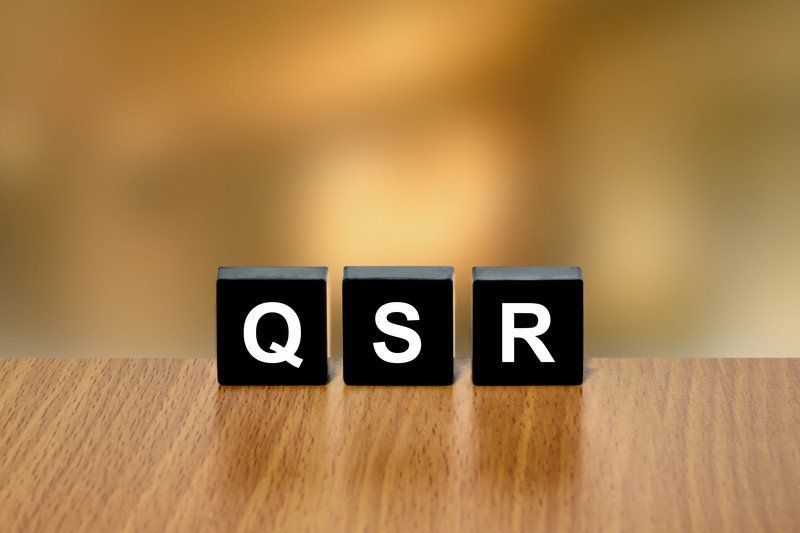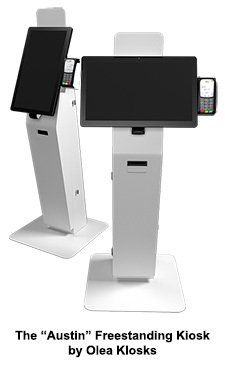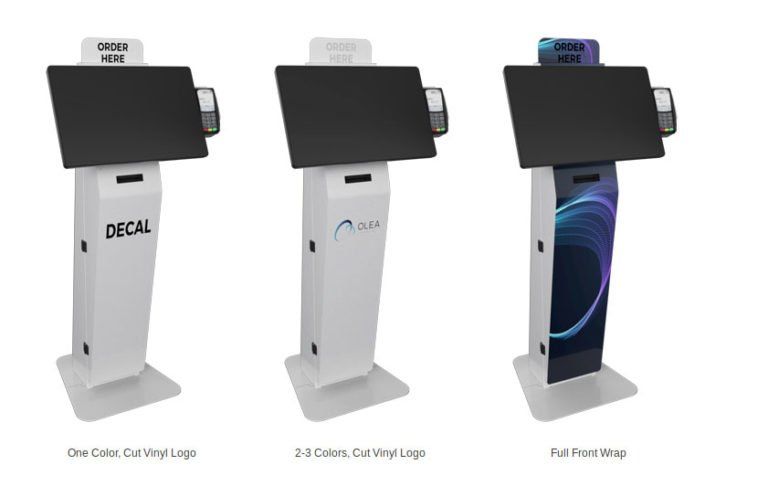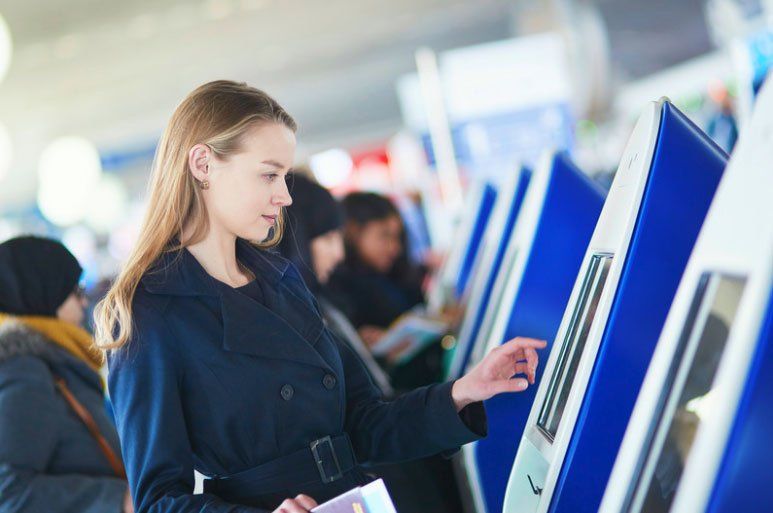The Five Top Technology Trends in QSR Market for 2019
May 21, 2019
A host of new technologies are on the horizon for the QSR industry. For many of them, a self-order kiosk will serve as their foundation.
Quick-service restaurants have long had a reputation for being innovators when it comes to technology. In the early days of modern foodservice, QSRs were among the first to incorporate features such as drive-thru speaker system and cooking timers. Later, computerized point-of-sale systems and digital menu boards emerged.
More recently, it’s been mobile apps, online ordering and point-of-sale systems that trigger menu boards to display promotions or remove items based on low inventory levels. Facial and AI-based response systems now generate context. Moreover, of course, one of the most significant technological trends affecting the QSR industry over the past few years has been the self-order kiosk.
Customer Data Context
However, the developments haven’t stopped there. All of these trends have one feature in common: They provide operators with a firehose of data they can use to improve their operations.
McDonald’s, for example, acquired software company Dynamic Yield in March for $300 million, giving it technology that will allow it to customize digital menu boards based on data including time of day, weather and current ordering trends to deliver a more personalized in-store experience. The fast-food giant also took a stake in software company Plexure in April, giving it access to a mobile platform that uses digital marketing tools to increase sales. The platform manages mobile-based promotional offers and a customer loyalty program as well as serving as the backbone of McDonald’s mobile app.
Elsewhere, self-order kiosks at some locations of the South Florida-based BurgerFi chain are incorporating facial recognition technology that gives customers the option of saving previous orders along with phone numbers and facial geometry. The next time a customer visits a location, they’ll be recognized by the kiosk and will be given the option to use that stored information on their current order. Other chains including Dallas-based Malibu Poke, Pasadena, Calif.-based Caliburger and Philadelphia-based Bryn & Dane’s are using variations on the technology.
Drive-Thru Ordering
Because 70 percent of the revenue for a typical QSR comes via the drive-thru, it only makes sense to look there as an avenue for technological improvements. Digital menu boards have been appearing in drive-thru lanes for several years, and will likely be standard going forward. Companies including Dunkin’ Brands have eyed dedicated pickup lanes for mobile orders as a way to eliminate bottlenecks, although the idea seems to be slowly gaining traction. Also, several kiosk manufacturers have introduced devices designed for the drive-thru in recent years as restaurant operators seek to duplicate the success of dining-room self-order technology. Olea Kiosks’ Detroit model was an early entry into that category. Technology provider Xenial, which provided the facial recognition application for Bryn & Danes, has installed touchscreen drive-thrus in nearly 400 Subway restaurants to date. Drive-Thrus have become so popular that some countries (Canada) and US cities are looking at restricting drive-thru’s.
Location-Based Customer Service
Location technology and geofencing appear to be an up-and-coming trend, with its potential demonstrated by Burger King’s recent Whopper Detour promotion. Customers who participated in the promotion, which ran in mid-December 2018, could purchase a Whopper for just a penny via their mobile app, as long as they were within 600 feet of a McDonald’s. Other applications for the technology include alerting restaurants when a carryout customer pulls into the parking lot, with restaurant staff then delivering that customer’s order to their car.
Standard features of the Austin Kiosk
- 15″ or 22″ All in One Computer
- Capacitive multi-touch touch sensor
- Durable powder coat paint finish
- 16 Gauge Galvanized Steel
- Security Locks
- Internal 6-outlet power strip w/ surge protection
- Topple resistant base plate with the ability to bolt to the ground
- Landscape Dimensions
- Width: 24.08”
- Height: 52.95″
- Depth: 20.63″
- Base plate: 24.08″ W x 20.63″ D
- Portrait Dimensions
- Width: 21”
- Height: 57.89″
- Depth: 20.63″
- Base plate: 21″ W x 20.63″ D
Automation – The Robots have arrived.
Artificial Intelligence or AI-based systems are already being tested. Holly, made by Valyant A.I., is a disembodied voice that takes drive-through orders at a Good Times in South Denver.
The Colorado fast food chain started experimenting with conversational A.I. to lighten the load of some of its employees who often juggle multiple tasks at the same time. Rob Carpenter, the founder of Valyant A.I., said the hospitality industry needs robots right now to make up for the lack of applicants.
“In the United States, because it’s such a tight labor market, there’s somewhere in the neighborhood of 800,000 unfilled positions,” Carpenter said.
Self-Service kiosks are driving trends
Many of these up-and-running technologies are likely to be incorporated into the self-order kiosks that have been at the heart of recent restaurant trends. There are plenty of reasons why: Research conducted by financial news site PYMNTS.com
found that consumers spend as much as 30 percent more at a self-order kiosk compared with other ordering methods. Self-order kiosks allow easy customization of orders, never forget to suggestive sell and eliminate the “indulgence guilt” that can occur when ordering extra-large fries or an apple pie for dessert.
Others are seeing even more significant results. Point-of-sale platform Appetize
recently reported that users of its self-service solution see a 40 percent increase in order size. Appetize’s Interact self-service solution offers embedded upsell functionality, and data shows that consumers are 47 percent more likely to add an item on a kiosk than when asked to do so by a cashier.
Research from ordering technology firm Tillster indicates the use of self-order kiosks will continue to grow for the foreseeable future. A 2018 Tillster study found that 54% of customers plan to place an order with a self-service kiosk within the next year, and if the line to order from a cashier is longer than five people, 75 percent of customers will choose to order from a self-service kiosk.
And although mobile apps may serve as an additional ordering channel that enhances the QSR experience, they’ll never supplant self-order kiosks (despite predictions from app designers). Although there may be some among us who gravitate to mobile apps, there are too many restaurant choices and not enough space on our devices to hold apps for each one. And anyway, who wants to go through the hassle of downloading an app to place an order when there’s a self-order kiosk already available? Instead, it’s likely that both channels will thrive.
However, with many of these technologies built on self-order kiosks, their success will hinge on the quality of those kiosks. Olea’s offering in the self-order kiosk arena, for example, is its sleek and modern Austin Freestanding Kiosk. Olea also performed custom kiosk work and purpose-built the kiosks Appetize is using to achieve its dramatic results.
The Austin works in any environment and continues Olea’s mission to provide better kiosks through intelligent design. To maintain the flexible configuration capability, the Austin is engineered to accommodate an optional 15″ or 22″ All-in-One computer in either portrait or landscape as well as an EMV-approved Card Reader & Pin Pad and POS-style receipt printer.
The wide array of transactional components housed in this sleek, feature-packed kiosk makes it one of the most powerful retail solutions available on the market. Its compact footprint and rugged security complement a variety of environments for companies that seek to improve ROI and user interaction in small spaces or high traffic areas.
The adoption of new technologies is setting the stage for exciting (and profitable) times in the QSR space. Olea Kiosks stands ready to help! Feel free to call us at 800.927.8063
or email us at info@olea.com.
Contact Olea Kiosks today at 800.927.8063 for more information
Contact Us
Payment Kiosk News

Although it remains to be seen if the use of cash as a form of payment will eventually disappear, don’t expect it to happen any time soon. Consumers used cash in 26 percent of transactions last year, according to the Federal Reserve’s 2019 Diary of Consumer Payment Choice. Although that’s down from 30 percent in 2017, it’s a far cry from total elimination. Another few tidbits from the Fed report: Participants in the study used cash for 35 percent of in-person payments, and cash represented 49 percent of payments under $10. Of all the cash payments reported, the study found, 80 percent were for payments below $25. Underbanked, non-banked and the kiosk industry Well, let’s start with those figures on cash payments. Some of the strongest growth the kiosk industry is seeing these days is in the self-order arena, specifically in fast-food restaurants. Those transactions are typically $20 or less, right in the sweet spot for cash usage. Billpay kiosks are growing in popularity as well, targeting underbanked consumers or those who don’t have the ability to pay bills online. Some of the deployed applications include water bill payment, electricity bill pay, gas bill pay and light bill pay. 30% (and rising) of the US population is lower class living in apartments, renting housing. 25% of the US population is unbanked or underbanked according to a 2017 survey by the Federal Deposit Insurance Corp and that number is considered low. Again, the type of people who are likely to favor cash. So if credit cards are the only payment option, a company that relies on self-service kiosks may be missing out on substantial revenue opportunities. Still, accepting cash does present obstacles deployers need to overcome. And with the use of alternative forms of payment on the rise, deployers need to plan for those as well. Utility Bill Payment Example Eliminating the hurdles Although it’s certainly much simpler to only accept cards as payment, a successful kiosk project is likely to involve the ability to accept cash as a form of payment. “As a business decision, I don’t believe that excluding paying customers is an effective way to win business,” said Thomas Smith, CEO of Providence, R.I-based Self-Service Networks. “If a customer wants to purchase your products and services, there should be no barriers created that would prevent them from making that purchase.” In fact, the ability to accept cash may be critical to a project’s success. Chicago’s Department of Finance, for example, began rolling out self-serve kiosks in 2007, allowing citizens to pay for everything from parking tickets to utility bills. The kiosks accept a variety of payment methods, but 47 percent of those payments are made in cash. “Since the beginning, cash has always been most popular at the kiosks,” Tina Consola, first deputy director of the department, told the trade news website PYMNTS.com. “It’s important to serve customers who primarily pay in cash, because they may not have access to a checking account or credit card.” Aside from the obvious security concerns, one of the main issues when it comes to accepting cash is the quality of the cash itself. Most of us can recall at some point in their lives trying to purchase a soft drink or candy bar from a vending machine, only to see their dollar bill rejected time and time again. “Unless the operator is using a high quality bill acceptor from MEI or JCM, lower quality notes may not be accepted at a high rate, thus reducing revenue generated by the unit,” said Dylan Waddle, chief operating officer with Norman, Okla.-based M3t Financial Services, a provider of cash management software solutions. In addition, the issue of dispensing change presents another challenge (and expense). “It is always easier to round off transaction amounts to the nearest dollar to lessen the burden of dealing with coin,” Waddle said. “Over the past 10 years, M3t has been testing new and innovative ways to deal with coin and even the most sophisticated methods still have issues with coins jamming in transition to the customer,” he said. “Coins also drive a much larger footprint for the kiosk unit itself, so if they can be avoided, it is much preferred.” Cash Collection Other concerns are the expense and time involved in pulling cash from a kiosk and taking it to the bank. At the very least, those tasks can take an hour or more per day, while for busy locations it can mean hiring an armored car service to handle the cash. Whatever the challenge, though, the use of cash isn’t going away. If the kiosk itself doesn’t accept cash, merchants may be forced to provide an alternative payment channel for those who prefer to conduct business with currency. “Legislative pressures forcing brick and mortar retailers to accept cash is definitely a growing trend,” Smith said. “In fact, our beloved Rhode Island is one of the first states (if the only) to pass a law to require cash acceptance at brick and mortar retailers.” And legislation affects insurance for cash services. In Colorado and other states which have legalized marijuana one of the biggest problems is hiring insured cash collection services. There are workarounds but this has put a damper on the cannabis kiosk since most of the transactions are cash. Bitcoin Kiosks – Hidden opportunities? Although accepting cash can certainly complicate a kiosk project, doing so can reap some unexpected benefits. Along with the potential for increased sales, kiosks can simplify the cash management process. “Cash accepting systems can reduce cash shrinkage because employees rarely touch or count money,” said Douglas Shipley, OEM Sales Manager, North America with Glory Global Solutions. Glory is a provider of secure, efficient payment systems, cash recyclers and instant, highly accurate identity verification and authentication solutions. “Glory cash automation machines accept, count, sort and dispense change while keeping an accurate accounting of cash on hand,” Shipley said. “Counterfeit bills detection is also built in.” The addition of cash acceptance to self-serve kiosks also speeds realization of revenue because the funds may be immediately available for deposit, Shipley said. Credit card payments, on the other hand, require processing time as well as the imposition of fees by banking institutions. Although accepting cash can certainly complicate a kiosk project, the growing number of payment channels is opening up new markets for kiosk providers as well. Bitcoin kiosks, for example, is one of the fastest-growing segments in the world due to the increased popularity of cryptocurrency. Those devices allow users to buy and sell bitcoin and similar cryptocurrencies with cash. “Our company expects to have over 1,000 Bitcoin ATMs deployed by the end of 2020,” said Brandon Mintz, CEO of Atlanta-based Bitcoin Depot. The bitcoin kiosk industry is projected to grow at a compound annual rate of 46.6 percent by 2024. Mintz’s company recently acquired competitor DFW Bitcoin. Reverse ATMs, Gift Card Kiosks and Cash2Card Opportunities There are also situations a consumer might want to convert their cash into a payment card. Maybe they want to purchase an item online and don’t wish to use (or don’t have) a credit or debit card. Maybe they want to give someone a gift, but feel that cash in an envelope is a bit tacky. Whatever the reason, Self-Service Networks caters to those consumers with its GiftWise Cash-2-Card and gift card vending kiosks. Those devices allow consumers to convert cash into a payment card, gift card or other digital asset. The opportunities for kiosks that accept cash are many, but getting the most from them requires a kiosk that is designed to accept cash, backed by a vendor who’s experienced in supporting those deployers who include those in their kiosk fleet. Olea Financial Kiosks Portfolio Olea Kiosks offers a number of kiosk models that can be customized to accept cash, print receipts, dispense tickets and more. The company’s Franklin Bill Pay Kiosk, for example, is designed to simplify cash transactions. Standard options include a high-capacity bill acceptor, bill dispenser, cash recycler options, high speed bulk note acceptor, coin dispenser, multiple biometrics and receipt printer. Olea’s Austin Kiosk is engineered for light and medium bill payment, featuring a 15” or 22” All-in-One computer in either portrait or landscape as well as an EMV credit card terminal and POS-style receipt printer. The Austin can be customized to support card issuance for gift card and Cash2Card applications. Olea can assist you with a complete range of financial services including processing, EMV payment, turnkey financial software, solution servicing, financing, cash collection services and even revenue-sharing options. We are your complete financial services partner.No matter what the challenge when it comes to accepting cash, Olea offers a payment kiosk solution to meet that challenge. Contact us at 800-927-8063 or email info@olea.com. We stand ready to help. More Information on Bill Pay Kiosks Considerations When It Comes to Bill Payment Kiosks Bill Pay Kiosks: The Business Models and Keys to Success, Part I Bill-Pay and Other Financial Kiosks The Top 3 Reasons Casino Loyalty Kiosks Can Benefit Your Casino

DENVER — The Denver Broncos, in conjunction with Aramark, formally unveiled concessions improvements at Empower Field at Mile High. They released a nice video going thru the various changes. The key changes are to increase speed of service. In the video you can see Aramark highlighting the self-order stations from Appetize (made by Olea Kiosks ). “Empower Field at Mile High is constantly looking for ways to improve the fan experience, and we are confident that with Aramark as our concessionaire we can modernize how fans enjoy food and beverages at our stadium events,” Stadium General Manager, Empower Field at Mile High, Jay Roberts said. “We are also thrilled to debut several newly renovated concession stands on Sunday, which is the first step in a multi-year process to improve speed of service while also adding more variety to the menu.” “We’re excited to expand our partnership with the Broncos and undertake this transformation of Empower Field at Mile High’s dining experience,” Jay Morrison, District Manager, Aramark’s Sports & Entertainment division, said. “We have a long, proud history of serving Denverites and, with our close ties to the community and knowledge of the local food scene, I’m confident we will deliver an innovative, dynamic and engaging food and beverage experience for everyone attending events at the stadium.” Read the full article at Denver Broncos










